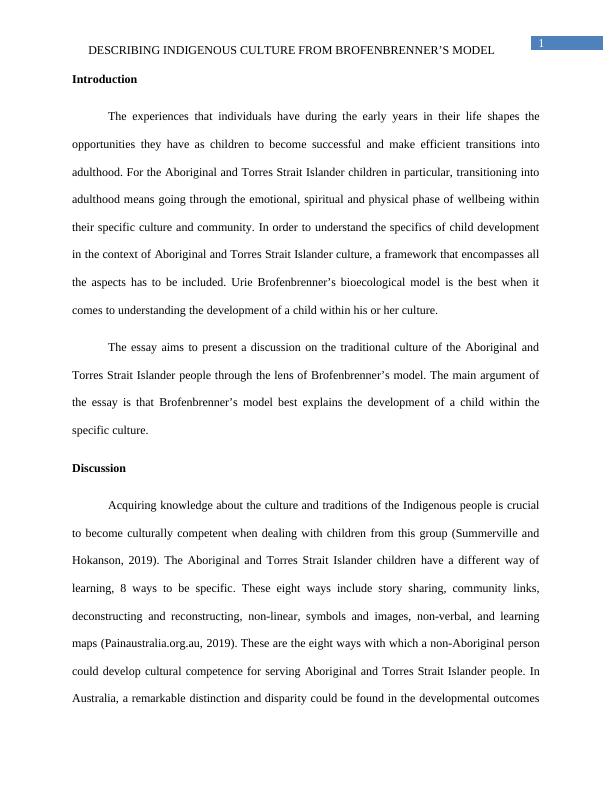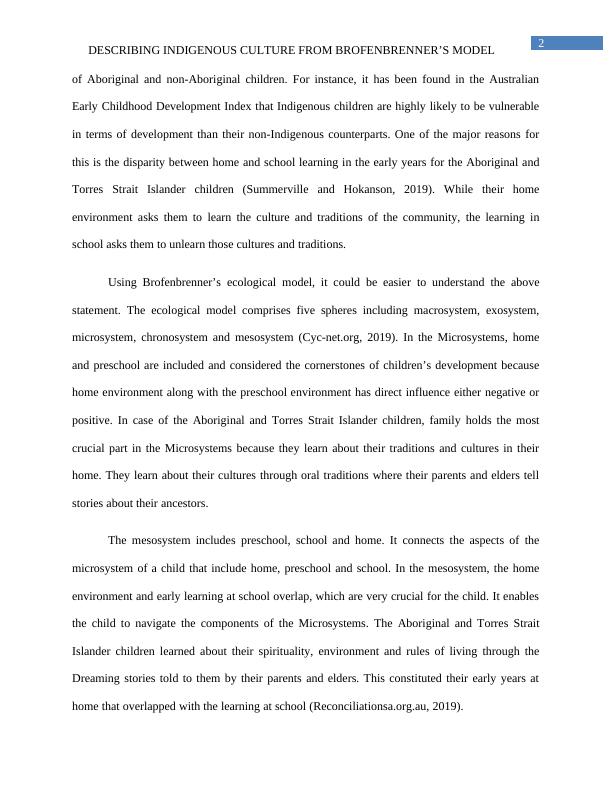Describing Indigenous Culture from Brofenbrenner's Model Essay 2022
Added on 2022-09-18
9 Pages1971 Words23 Views
Running head: DESCRIBING INDIGENOUS CULTURE FROM BROFENBRENNER’S MODEL
DESCRIBING INDIGENOUS CULTURE FROM BROFENBRENNER’S MODEL
Name of the student
Name of the university
Author note
DESCRIBING INDIGENOUS CULTURE FROM BROFENBRENNER’S MODEL
Name of the student
Name of the university
Author note

1
DESCRIBING INDIGENOUS CULTURE FROM BROFENBRENNER’S MODEL
Introduction
The experiences that individuals have during the early years in their life shapes the
opportunities they have as children to become successful and make efficient transitions into
adulthood. For the Aboriginal and Torres Strait Islander children in particular, transitioning into
adulthood means going through the emotional, spiritual and physical phase of wellbeing within
their specific culture and community. In order to understand the specifics of child development
in the context of Aboriginal and Torres Strait Islander culture, a framework that encompasses all
the aspects has to be included. Urie Brofenbrenner’s bioecological model is the best when it
comes to understanding the development of a child within his or her culture.
The essay aims to present a discussion on the traditional culture of the Aboriginal and
Torres Strait Islander people through the lens of Brofenbrenner’s model. The main argument of
the essay is that Brofenbrenner’s model best explains the development of a child within the
specific culture.
Discussion
Acquiring knowledge about the culture and traditions of the Indigenous people is crucial
to become culturally competent when dealing with children from this group (Summerville and
Hokanson, 2019). The Aboriginal and Torres Strait Islander children have a different way of
learning, 8 ways to be specific. These eight ways include story sharing, community links,
deconstructing and reconstructing, non-linear, symbols and images, non-verbal, and learning
maps (Painaustralia.org.au, 2019). These are the eight ways with which a non-Aboriginal person
could develop cultural competence for serving Aboriginal and Torres Strait Islander people. In
Australia, a remarkable distinction and disparity could be found in the developmental outcomes
DESCRIBING INDIGENOUS CULTURE FROM BROFENBRENNER’S MODEL
Introduction
The experiences that individuals have during the early years in their life shapes the
opportunities they have as children to become successful and make efficient transitions into
adulthood. For the Aboriginal and Torres Strait Islander children in particular, transitioning into
adulthood means going through the emotional, spiritual and physical phase of wellbeing within
their specific culture and community. In order to understand the specifics of child development
in the context of Aboriginal and Torres Strait Islander culture, a framework that encompasses all
the aspects has to be included. Urie Brofenbrenner’s bioecological model is the best when it
comes to understanding the development of a child within his or her culture.
The essay aims to present a discussion on the traditional culture of the Aboriginal and
Torres Strait Islander people through the lens of Brofenbrenner’s model. The main argument of
the essay is that Brofenbrenner’s model best explains the development of a child within the
specific culture.
Discussion
Acquiring knowledge about the culture and traditions of the Indigenous people is crucial
to become culturally competent when dealing with children from this group (Summerville and
Hokanson, 2019). The Aboriginal and Torres Strait Islander children have a different way of
learning, 8 ways to be specific. These eight ways include story sharing, community links,
deconstructing and reconstructing, non-linear, symbols and images, non-verbal, and learning
maps (Painaustralia.org.au, 2019). These are the eight ways with which a non-Aboriginal person
could develop cultural competence for serving Aboriginal and Torres Strait Islander people. In
Australia, a remarkable distinction and disparity could be found in the developmental outcomes

2
DESCRIBING INDIGENOUS CULTURE FROM BROFENBRENNER’S MODEL
of Aboriginal and non-Aboriginal children. For instance, it has been found in the Australian
Early Childhood Development Index that Indigenous children are highly likely to be vulnerable
in terms of development than their non-Indigenous counterparts. One of the major reasons for
this is the disparity between home and school learning in the early years for the Aboriginal and
Torres Strait Islander children (Summerville and Hokanson, 2019). While their home
environment asks them to learn the culture and traditions of the community, the learning in
school asks them to unlearn those cultures and traditions.
Using Brofenbrenner’s ecological model, it could be easier to understand the above
statement. The ecological model comprises five spheres including macrosystem, exosystem,
microsystem, chronosystem and mesosystem (Cyc-net.org, 2019). In the Microsystems, home
and preschool are included and considered the cornerstones of children’s development because
home environment along with the preschool environment has direct influence either negative or
positive. In case of the Aboriginal and Torres Strait Islander children, family holds the most
crucial part in the Microsystems because they learn about their traditions and cultures in their
home. They learn about their cultures through oral traditions where their parents and elders tell
stories about their ancestors.
The mesosystem includes preschool, school and home. It connects the aspects of the
microsystem of a child that include home, preschool and school. In the mesosystem, the home
environment and early learning at school overlap, which are very crucial for the child. It enables
the child to navigate the components of the Microsystems. The Aboriginal and Torres Strait
Islander children learned about their spirituality, environment and rules of living through the
Dreaming stories told to them by their parents and elders. This constituted their early years at
home that overlapped with the learning at school (Reconciliationsa.org.au, 2019).
DESCRIBING INDIGENOUS CULTURE FROM BROFENBRENNER’S MODEL
of Aboriginal and non-Aboriginal children. For instance, it has been found in the Australian
Early Childhood Development Index that Indigenous children are highly likely to be vulnerable
in terms of development than their non-Indigenous counterparts. One of the major reasons for
this is the disparity between home and school learning in the early years for the Aboriginal and
Torres Strait Islander children (Summerville and Hokanson, 2019). While their home
environment asks them to learn the culture and traditions of the community, the learning in
school asks them to unlearn those cultures and traditions.
Using Brofenbrenner’s ecological model, it could be easier to understand the above
statement. The ecological model comprises five spheres including macrosystem, exosystem,
microsystem, chronosystem and mesosystem (Cyc-net.org, 2019). In the Microsystems, home
and preschool are included and considered the cornerstones of children’s development because
home environment along with the preschool environment has direct influence either negative or
positive. In case of the Aboriginal and Torres Strait Islander children, family holds the most
crucial part in the Microsystems because they learn about their traditions and cultures in their
home. They learn about their cultures through oral traditions where their parents and elders tell
stories about their ancestors.
The mesosystem includes preschool, school and home. It connects the aspects of the
microsystem of a child that include home, preschool and school. In the mesosystem, the home
environment and early learning at school overlap, which are very crucial for the child. It enables
the child to navigate the components of the Microsystems. The Aboriginal and Torres Strait
Islander children learned about their spirituality, environment and rules of living through the
Dreaming stories told to them by their parents and elders. This constituted their early years at
home that overlapped with the learning at school (Reconciliationsa.org.au, 2019).

End of preview
Want to access all the pages? Upload your documents or become a member.
Related Documents
Australian Indigenous and Multicultural Educationlg...
|9
|2203
|492
Closing The Gap: An Australian Government Strategylg...
|6
|1243
|222
Indigenous Studies and Learning: Impact of Culture and Linguistic Background on Educationlg...
|7
|1680
|276
Health Disparity in Hearing, Sight and Other Senses among Aboriginal and Torres Strait Islander Population of Australialg...
|11
|2331
|233
Indigenous Studies and Learningslg...
|12
|1239
|484
Diabetes Incidence among the Australian Indigenous Populationlg...
|10
|2433
|182
